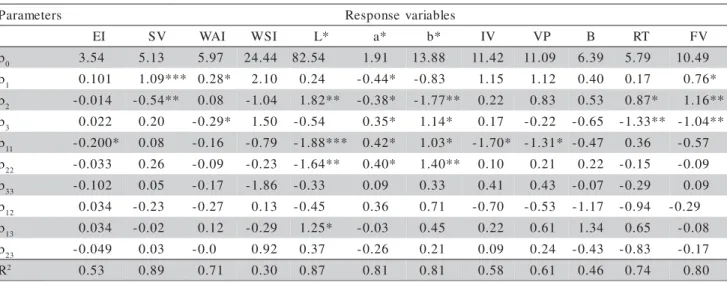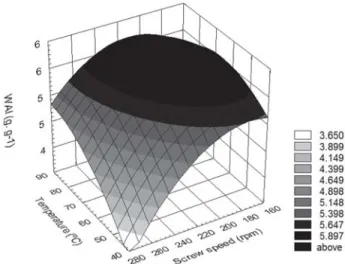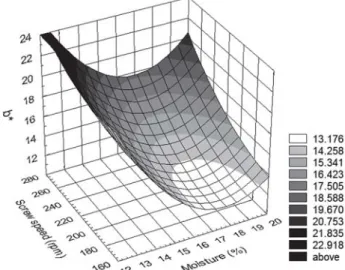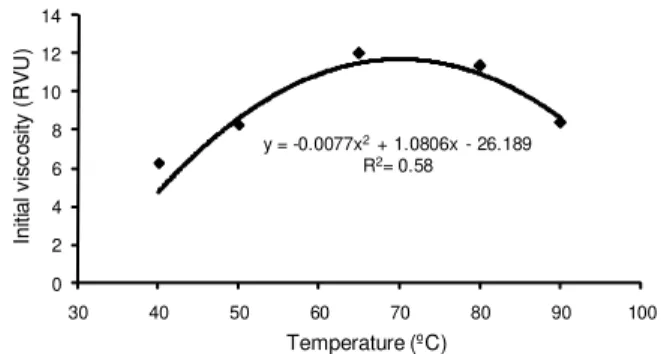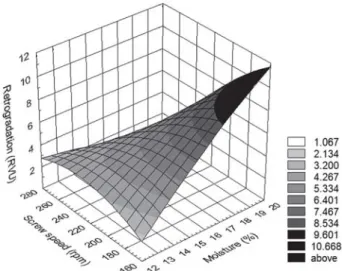PHYSICAL CHARACTERISTICS OF EXTRUDED
CASSAVA STARCH
Magali Leonel1*; Taila Santos de Freitas1; Martha Maria Mischan2
1
UNESP Centro de Raízes e Amidos Tropicais, R. José Barbosa de Barros, 1780 18610307 Botucatu, SP Brasil.
2
UNESP - Instituto de Biociências, Distrito de Rubião Júnior s/n – 18618-000 - Botucatu, SP - Brasil. *Corresponding author <mleonel@fca.unesp.br>
ABSTRACT: Considering the importance of cassava starch for Brazilian industries, the current work aimed at evaluating the effects of extrusion parameters on the physical characteristics, mainly viscosity properties of extruded cassava starch. A factorial central composite design (23
) with three independent variables and the response surface methodology were used to evaluate the results of expansion index, specific volume, water absorption index, water solubility index, color and paste properties, according to the variations in the moisture content, barrel temperature and screw speed. Results indicated that barrel temperature influenced the expansion index, specific volume, water absorption index, all the color parameters, the initial viscosity, peak and final viscosity. Feed moisture influenced the specific volume, color parameters, final viscosity and retrogradation. The screw speed had effects on water absorption index, color components as well as on the final viscosity and retrogradation of extruded starch. High moisture, low screw speed and intermediate temperature provided lower starch degradation, which is desirable for pre-cooked starch.
Key words: Manihot esculenta, modified starch, extrusion, viscosity
CARACTERÍSTICAS FÍSICAS DE AMIDO DE
MANDIOCA EXTRUSADO
RESUMO: Considerando a importância do amido de mandioca para as indústrias brasileiras, este trabalho teve por objetivo avaliar os efeitos de parâmetros de extrusão sobre as características físicas e propriedades de pasta do amido de mandioca extrusado. Foi utilizado o delineamento fatorial do tipo central composto rotacional com três variáveis independentes (23
) e a metodologia de superfície de resposta para avaliar os resultados de índice de expansão, volume específico, índice de absorção de água, índice de solubilidade em água, cor e propriedades de pasta, de acordo com as variações de umidade, temperatura de extrusão e rotação da rosca. A temperatura de extrusão influenciou o índice de expansão, volume específico, índice de absorção de água, todos os parâmetros de cor e a viscosidade inicial, pico e viscosidade final. Já a umidade teve influência sobre o volume específico, parâmetros de cor, viscosidade final e tendência a retrogradação. A rotação da rosca teve efeito no índice de absorção de água, nos componentes de cor bem como viscosidade final e na tendência à retrogradação do amido extrusado. Nas condições operacionais de elevada umidade inicial da matéria-prima, baixa rotação da rosca e temperatura de extrusão no nível intermediário ocorreu menor degradação do amido, o que é desejável em amidos pré-gelatinizados.
Palavras-chave: Manihot esculenta, amido modificado, extrusão, viscosidade
INTRODUCTION
Cassava is the second most important source of starch in Brazil, constituting an industrial input into strategic sectors of the economy. In 2005, the coun-try produced 26.8 million tons of cassava roots within an area of 1.9 million ha, and the main producers were the states of Pará, Bahia, Paraná, Maranhão and Rio Grande do Sul. In the same year, the production of cassava starch yielded 546.5 thousand tons, and the Paraná State was the greatest producer (IBGE, 2007).
Modified starch is mainly used in Brazil by the pa-per industry, and smaller amounts are destined to the food and textile sectors. Generally, native starch is not the most appropriate form for specific processing. Therefore it is modified in order to obtain starchy prod-ucts that have the properties needed for specific uses (Franco et al., 2001).
constitutes the basis for previously prepared food (Franco et al., 2001).
Extrusion has gained emphasis and expansion in the food industry since it is an important technique which, besides increasing the variety of processed food, pre-sents more advantages when compared with other tra-ditional systems of food processing. The rapid accep-tance of food extrusion as an important food process-ing operation has resulted because of the many advan-tages of the use of extrusion. First, extruders achieve high productivity in a single processing step by cool-ing and formcool-ing the product, thus, enhanccool-ing the cost effectiveness of the process. The ability of an extruder to handle a wide variety of raw ingredients and pro-cessing conditions assures its versatility and conse-quently broadens its applicability to a myriad of food products (Harper, 1981).
Extrusion alters several of the starch functional properties which mainly depend on the relation amy-lose-amylopectin as well as on the operational param-eters of the process such as the raw-material mois-ture content, the barrel temperamois-ture,the screw speed and geometry (Harper, 1981). Extrusion of starchy food results in gelatinization, partial or complete de-struction of the crystalline structure and molecular fragmentation of starch polymers, as well as protein denaturation, and formation of complexes between starch and lipids, and between protein and lipids (Colonna & Mercier, 1983).
Gelatinized starches have numerous industrial, nonfood uses such as in drilling oil wells, sizing tex-tiles, paper making, charcoal briqueting, and in ob-taining water-base paints. In food, gelatinized starches can be used almost any time thickening is desired. The gelatinization of starch also significantly affects the characteristics and quality of food such as loaf volume and crumb bread, the elasticity and softness of paste products, digestibility and palatability, the tol-erance of batter properties in cakes, frostings, and doughnut mixes, the sugar crystal growth in foods, and the texture, volume, shelf-life, and freeze-thaw stability of bread and cakes (Chiang & Johnson, 1977).
The current study aimed at evaluating the ef-fects of the operational conditions of the extrusion
pro-cess on the physical properties of extruded cassava starch, including viscosity due the importance of this starch in Brazil.
MATERIAL AND METHODS
A commercial cassava starch was used and mois-ture, ash, protein, lipids, starch, total sugar and fiber content were characterized according to the method-ology of AACC (1995). Extrusion was carried out us-ing a complete line of IMBRA RX (Inbramaq), which has a motor coupled with a speed reducer (extrusion by mechanical friction); a single extrusion screw; a hydraulic cooling system for temperature control;
vari-able speed; and capacity of 45 kg h–1.
The extrusion process parameters were:
Constant parameters: extrusion temperature in the
1st (20°C) and 2nd zones (60°C); screw compression
ra-tio (3:1); die diameter (5 mm); feed rate (200 g min–1);
and cutting speed (90 rpm).
Variable parameters: feed moisture; barrel
tempera-ture in the 3rd zone; and screw speed (Table 1). The
ranges of variation between the upper and lower limit of variables were established from preliminary tests.
The ‘central composite rotational’ design for three fac-tors was adopted, according to Cochran & Cox (1957), including a total of 15 treatments, as follows: eight
treat-ments corresponded to a 23 factorial, where the three
fac-tors were S = screw speed (rpm); T = barrel
tempera-ture (oC); M = feed moisture (%); each one at two
lev-els coded as –1 and +1; six treatments included the
mini-mum and maximini-mum levels of each factor coded as –α
and + α, respectively, where α = 23/4 = 1.682 ; one
cen-tral treatment was repeated six times, in which all fac-tors were at an average level coded as zero (Table 1).
The expansion index (EI) was evaluated after ex-trusion and before drying. It was calculated using the relation between sample and die diameters (Faubion & Hoseney, 1982). The considered value was obtained by the arithmetic mean of the measurements of 20 ex-panded products in each treatment. Specific volume was determined according to the mass displacement method (millet seed) using a graded pipette (Faubion & Hoseney, 1982).
Table 1- Levels of variation and variable parameters of the extrusion process.
<alpha> = 1.682
e l b a i r a v t n e d n e p e d n
I Levels ofvariation
> a h p l a <
- -1 0 +1 +<alpha>
) m p r ( d e e p s w e r c
S 140 190 218 246 266
) C º ( e r u t a r e p m e t n o i s u r t x
E 40 50 65 80 90
) % ( t n e t n o c e r u t s i o
Water absorption index (WAI) and water solubility index (WSI) were assessed before and after treatments (Anderson et al., 1969).
Color of the products was evaluated using a
colo-rimeter Minolta CR-400. Results were expressed as
L*, a* and b* values, where L* (luminosity or clar-ity) values varied from black (0) to white (100), chroma a* values varied from green (-60) to red (+60), and chroma b* values varied from blue (-60) to yel-low (+60).
To evaluate the properties of cassava starch paste, non-extruded and after treatments, a Rapid Visco
Analyser (RVA), series 4, Newport Scientific, was used
for starch suspensions (3.5 g starch in 25 mL H2O)
corrected to 14% humidity base. One g of ethanol was
added to the sample as recommended to Extrusion 2
method of NEWPORT SCIENTIFIC (1998). The ap-parent viscosity was expressed in RVU. The follow-ing characteristics were evaluated from the obtained graph: pasting temperature, maximum peak viscosity, breakdown viscosity (difference between the maximum and post-peak minimum viscosity), final viscosity, and setback (difference between the final viscosity and the minimum post-peak viscosity).
RESULTS AND DISCUSSION
The centesimal composition of the cassava starch indicated: 12.2% of moisture, 88.43% of starch, 0.15% of fiber, 0.14% of total sugar, 0.26% of lipids, 0.07% of protein and 0.1% of ash, showing that the product is in agreement with the legislation demands ( BRASIL, 1978). Table 2 summarizes the estimated regression
coeficients for the quadratic models fitted to the experi-mental results and their significance together with their corresponding coefficients of determination.
The EI of cassava starch expanded products ranged from 2.79 to 3.69. There were no effects of extru-sion temperature, feed moisture and screw speed. However, the lower expansion index was observed at the maximum level of temperature and central condi-tion of moisture and screw speed. The degree of ex-pansion of extrudade was closely related to the size, number and distribution of air cells surrounded by the cooked material. At very high temperature, however, the vaporization occurs in a violent way and may cause breakage of the structure, hampering expansion (Hashimoto & Grossmann, 2003).
Chang & El-Dash (2003) reported similar results for extruded cassava starch. Moisture (26 - 24%), fol-lowed by barrel temperature (120–200°C), affected the expansion at constant speed of 100 rpm. Under low moisture conditions, an increase in barrel temperature led to increased expansion. High feed moisture and high barrel temperature conditions decreased expan-sion. Expansion is related to the starch gelatinization degree (Chang & El-Dash, 2003). Low moisture con-tent in the material may restrain its flow inside the ex-truder, increasing shear and residence time, which could increase the gelatinization degree.
The specific volume varied from 3.56 mL g–1 to
7.57 mL g–1. There was an effect of barrel
tempera-ture and feed moistempera-ture on the specific volume of ex-panded products. Under low feed moisture and high barrel temperature conditions, the obtained products presented greater specific volumes (Figure 1).
Table 2- Regression equation coefficients (model Yk= b0 + ∑
=
3
1
i bi xik + ∑=
3
1
i ∑=
3
i
j bij xik xjk + ek ) (* = p < 0.05, ** = p < 0.01,
***= p < 0.001).
b1 = extrusion temperature; b2 = moisture; b3 = screw speed; EI = expansion index; SV = specific volume; WAI = water absorption index; WSI = water solubility index; IV = viscosity index; VP = Viscosity Peak; B = breakdown; RT = retrogradation tendency; FV = final viscosity; L* = luminosity; a* = chroma a*; b* = chroma b*.
s r e t e m a r a
P Responsevariables
I
E SV WAI WSI L* a* b* IV VP B RT FV
b0 3.54 5.13 5.97 24.44 82.54 1.91 13.88 11.42 11.09 6.39 5.79 10.49
b1 0.101 1.09*** 0.28* 2.10 0.24 -0.44* -0.83 1.15 1.12 0.40 0.17 0.76*
b2 -0.014 -0.54** 0.08 -1.04 1.82** -0.38* -1.77** 0.22 0.83 0.53 0.87* 1.16**
b3 0.022 0.20 -0.29* 1.50 -0.54 0.35* 1.14* 0.17 -0.22 -0.65 -1.33** -1.04**
b11 -0.200* 0.08 -0.16 -0.79 -1.88*** 0.42* 1.03* -1.70* -1.31* -0.47 0.36 -0.57
b22 -0.033 0.26 -0.09 -0.23 -1.64** 0.40* 1.40** 0.10 0.21 0.22 -0.15 -0.09
b33 -0.102 0.05 -0.17 -1.86 -0.33 0.09 0.33 0.41 0.43 -0.07 -0.29 0.09
b12 0.034 -0.23 -0.27 0.13 -0.45 0.36 0.71 -0.70 -0.53 -1.17 -0.94 -0.29
b13 0.034 -0.02 0.12 -0.29 1.25* -0.03 0.45 0.22 0.61 1.34 0.65 -0.08
b23 -0.049 0.03 -0.0 0.92 0.37 -0.26 0.21 0.09 0.24 -0.43 -0.83 -0.17
The increase of specific volume could be explained by the greater expansion in both axial and radial con-ditions. The volume expansion phenomena are basically dependent on viscous and elastic properties of melted dough. When temperature increases melt viscosity is reduced and the axial expansion increases (Liang et al., 1994). Alves and Grossmann (2002) also observed the influence of the raw-material moisture and the
extru-sion temperature on the production of snacksobtained
from Dioscorea alata flour. For 16% moisture, 170ºC
and die diameter of 3mm, a greater specific volume
(6.32 mL g–1), inferior to the mean value for
commer-cial corn snacks (8.72 mL g–1), was obtained.
The water absorption index (WAI) measures the volume occupied by the starch after swelling in ex-cess water, and indicates the integrity of starch in aqueous dispersion. Water solubility index (WSI), of-ten used as an indicator of degradation of molecular components, measures the degree of starch conver-sion during extruconver-sion which is the amount of soluble polysaccharide released from the starch component after extrusion (Yang et al., 2008). The WSI obtained in the different extrusion treatments ranged from 12.3 to 30.74%. Considering the WSI of cassava starch before extrusion (0.69%), there was a pronounced in-crease in solubility with the process, independent of the tested conditions. Effects of barrel temperature, feed moisture and screw speed were not observed on this parameter.
The WAI of extruded cassava starch varied from
4.19 to 6.41g g –1; such values were higher than those
observed for non-extruded starch (1.64 g g –1). WAI
was affect by the extrusion temperature and screw speed. The higher water absorption index was ob-served at high extrusion temperature and low screw speed conditions (Figure 2). Only gelatinized starch
granules absorb water at room temperature and swell; however, starch fragmentation increases when the ge-latinization degree increases, decreasing thus water absorption. WAI and WSI are important parameters to define the applications of extrudates as ingredients. High WSI is related to the stickiness of extruded prod-ucts (Hashimoto & Grossmann, 2003).
Color is an important characteristic of extruded foods. Color changes can give information about the extent of browning reactions such as caramelization, Maillard reaction, degree of cooking and pigment deg-radation that take place during the extrusion process (Altan et al., 2008). Analysis of the starch color com-ponents before and after extrusion evidenced that the values of the L* component from extruded starch var-ied from 72.08 to 82.98, indicating a decrease in lu-minosity after extrusion when compared with the ini-tial luminosity of 92.21. Out of the parameters that constitute the regression model, barrel temperature and feed moisture affected luminosity. The interaction be-tween barrel temperature and screw speed also had a significant effect.
Under high feed moisture and high barrel tempera-ture conditions, there was less darkening of the ex-truded starch, i.e. greater L* (Figure 3). These results were different from those observed by Gutkoski & El-Dash (1999), who studied extruded oat products with moisture content varying from 17 to 24%, bar-rel temperature from 90ºC to 150ºC, and constant speed of 100rpm, and verified that the luminosity decreased linearly when barrel temperature increased.
Chroma a* (redness) values ranged from 1.52 to 5.26, which indicate that there was little variability in this parameter during the extrusion process, consid-ering it can vary from -60 to +60. Analysis of the re-gression coefficients showed effect of all three
fac-Figure 1- Effect of barrel temperature and feed moisture on the specific volume of extruded cassava starch at 218 rpm screw speed.
tors (barrel temperature, feed moisture and screw speed) on the chromaticity component a*. According to the model, under low feed moisture and low barrel temperature conditions and screw speed of 218rpm, higher chroma a* values were observed (Figure 4). Its highest values occurred at constant temperature (65ºC), high screw speed and low feed moisture (Fig-ure 5).
Responses of the b* color parameter, which rep-resents variation from blue to yellow, varied accord-ing to the treatment (from 11.35 to 20.71). All samples, however, had yellow color. Regression analysis indi-cated effects of moisture, screw speed and tempera-ture on this chromaticity component: under high feed moisture, low screw speed and intermediate barrel tem-perature conditions, chroma b* values were lower (Figures 6 and 7). The increase in barrel temperature increases color intensity, and high moisture conditions
result in brighter products since increase in moisture decreases the residence time, providing less non-en-zymatic darkening of extruded products (Badrie & Mellowes, 1991).
The initial viscosity at 25ºC was too close to zero (as expected) due to the absence of gelatinized starch. The curve showed an acute peak (characteristic of granules presenting structural homogeneity) followed by a pronounced fall, even before reaching 95°C, which revealed little stability of the hot paste during agitation. The viscosity peak (VP) of cassava starch was 439.67 RVU, breakdown (B) was 319.75 RVU, final viscosity (FV) was 217.83 RVU, retrogradation tendency (R) was 97.92 RVU, and paste temperature was 67.20ºC (Figure 8). The initial viscosity or cold viscosity indicates the capacity of the starch to absorb water at room temperature and to form paste, gel or viscous liquid. Cold viscosity values obtained for
ex-Figure 3 - Effect of barrel temperature and feed moisture on the luminosity (L*) of extruded cassava starch at 218 rpm screw speed.
Figure 4 - Effect of feed moisture and barrel temperature on chroma a* of extruded cassava starch at 218 rpm screw speed.
Figure 5 - Effect of feed moisture and screw speed on chroma a* of extruded cassava starch at 65°C barrel temperature.
Figure 7 - Effect of feed moisture and barrel temperature on chroma b* of extruded cassava starch at 218 rpm screw speed.
Figure 8 - Viscoamilography profile of cassava starch.
truded starch varied from 5.3 to 14.7 RVU. Consider-ing that the initial viscosity before extrusion was prac-tically zero, the extrusion treatments led to a consider-able increase in cold viscosity. Out of the factors con-stituting the model, barrel temperature affected viscos-ity, and no interference of feed moisture and screw speed were observed. The increase in extrusion tem-perature led to an increase of the initial viscosity and, above 70ºC, there was a tendency towards fall, indicat-ing degradation of the crystalline structure (Figure 9).
The viscosity peak increased as barrel temperature increased and decreased at the highest temperatures (Figure 10). However, the values obtained (6.33 to 14.58 RVU) were notably below those observed be-fore extrusion, indicating that the processing conditions provided high degradation of the starchy structure. Chiang & Johnson (1977) evaluated the effect of ge-latinization on wheat flour as a function of screw speed, operational temperature and water content, and
noticed that as temperature increased, gelatinization in-creased. They considered extrusion temperature and initial moisture content of the raw material as the vari-ables that had more pronounced effects on starch ge-latinization; they also verified that the maximum gela-tinization degree occurred when these variables acted with extreme opposite values.
The breakdown of the extruded products varied from 2.83 to 12.83 RVU. Analysis of the regression coefficients showed there was not effect of the fac-tors that constitute the model. However, the highest breakdown value was observed under low barrel tem-perature, low speed and high feed moisture conditions. Low breakdown values occurred because degradation of the starchy fraction did not lead to significant vis-cosity peaks. The high moisture content in the feed might act as a lubricant and reduce the melt viscosity during extrusion leading to high breakdown viscosity values.
The final viscosity (FV) of extruded starch varied from 7.25 to 13.1 RVU. Analysis of the regression co-efficients showed effect of barrel temperature, feed moisture and screw speed. Under low moisture con-ditions and high screw speed, FV were lower (Figure 11). Low moisture in the feed possibly increased fric-tional damage, particularly when the residence time was lower due to high screw speed. The highest
val-Figure 10 - Effect of barrel temperature on viscosity peak of extruded cassava starch at 16% feed moisture and 218 rpm screw speed.
y = -0.0059x2+ 0.8484x - 18.911
R2= 0.61
0 2 4 6 8 10 12 14
30 40 50 60 70 80 90 100
V
is
c
os
ity
pe
ak
(
R
V
U
)
Temperature (ºC) y = -0.0077x2+ 1.0806x - 26.189
R2= 0.58
0 2 4 6 8 10 12 14
30 40 50 60 70 80 90 100
In
iti
a
l v
is
c
o
sit
y
(
R
VU
)
Temperature (ºC)
ues occurred under the highest barrel temperature and feed moisture conditions (Figure 12).
Bhattacharya et al. (1999) evaluated the effect of the initial moisture content of the samples of mixtures of wheat flour and potato on the behavior of paste ex-truded products using Rapid Visco Analyser (RVA) and did not observe an accentuated increase in apparent viscosity during cooling, which indicated degradation of the starchy fraction during extrusion, resulting thus in an increase in FV at 50ºC. Similarly to the present research, the highest values of FV found by those au-thors occurred under high moisture conditions.
The retrogadation tendency values of the extruded products varied from 2.50 to 12.50 RVU. These low values indicated the severity of the treatments, caus-ing degradation of polymers, rupture of their molecu-lar structures, and reduction of their recrystallization
capacity. The adopted regression model was signifi-cant, and there was effect of feed moisture and screw speed on retrogradation. The highest retrogradation values were observed under high moisture and low screw speed conditions (Figure 13).
CONCLUSIONS
The operational conditions of the extrusion process affect paste properties. Cassava starch show small quantity of non-starchy components and its solubility and water absorption indexes were characteristic of non-gelatinized natural starch.
Extruded starch had less luminosity, higher chroma a* level, and greater intensity of chroma b* than na-tive starch.
There is a pronounced increase of the water solu-bility and water absorption indexes with the extrusion process. High moisture, low screw speed and inter-mediate temperature provide lower starch degradation what is desirable in pre-cooked starch.
Out of the extrusion parameters, barrel tempera-ture has the most pronounced effect on expansion, paste properties and color of extruded starch, followed by feed moisture and screw speed.
REFERENCES
ALTAN, A.; McCATHY, K.L.; MASKAN, M. Twin-screw extrusion of barley-grape pomace belnds: extrudate characteristics and determination of optimum processing conditions. Journal of Food Engineering, v.89, p.24-32, 2008.
ALVES, R.M.L.; GROSSMANN, M.V.E. Parâmetros de extrusão para produção de “snacks” de farinha de cará (Dioscorea alata).
Ciência e Tecnologia de Alimentos, v.22, p.32-38, 2002. AMERICAN ASSOCIATION OF CEREAL CHEMISTS – AACC.
Approved methods of the American Association of Cereal Chemists. 9ed. St. Paul: AACC, 1995. ?p.
Figure 11 - Effect of feed moisture and screw speed on the final viscosity of extruded cassava starch at 65°C barrel temperature.
Figure 12 - Effect of barrel temperature and feed moisture on the final viscosity of extruded cassava starch at 218 rpm screw speed.
ANDERSON, R.A.; CONWAY, H.F.; PFEIFER, V.F.; GRIFFIN JR., L. Gelatinization of corn grits by roll and extrusion cooking.
Cereal Science Today, v.14, p.4-11, 1969.
BRASIL. Leis, decretos, etc. Decreto nº 12.486 de 20 de outubro de 1978. Normas técnicas especiais relativas a alimentos e bebidas. Diário Oficial do Estado de São Paulo, 21 out. 1978. p.20. BADRIE, N.; MELLOWES, W.A. Effect of extrusion variables on
cassava extrudates. Journal of Food Science, v.56, p.1334-1337, 1991.
BHATTACHARYA, S., SUDHA, M. L., RAHIM, A. Pasting characteristics of an extruded blend of potato and wheat flours.
Journal of Engineering, v.40, p.107-111, 1999.
CHANG, Y.K.; EL-DASH, A.A. Effects of acid concentration and extrusion variables on some phisical characteristics and energy requirements of cassava starch. Brazilian Journal of Chemical Engeneering, v.20, p.129-137, 2003.
CHIANG, B.Y.; JOHNSON, J.A. Gelatinization of starch in extruded products. Cereal Chemistry, v.54, p.436-443, 1977. COCHRAN, W.G.; COX, G.M. Experimental Designs. 2 ed. New
York: John Wiley, 1957, 611 p.
COLONNA, P.; MERCIER, C. Macromolecular modifications of manioc starch components by extrusion-cooking with and without lipids. Cabohydrate Polymers, v.3, p.87-108, 1983. FAUBION, J.M.; HOSENEY, R.C. High temperature and short time; extrusion-cooking of wheat starch and flour. I. Effect of moisture and flour type on extrudate properties. Cereal Chemistry, v.59, p.529-533, 1982.
FRANCO, C.M.L.; DAIUTO, E.R.; DEMIATE, I.M.; CARVALHO, L.J.C.B.; LEONEL, M.; CEREDA, M.P.; VILPOUX, O.F.; SARMENTO, S.B.S. Propriedades gerais do amido. São Paulo: Fundação Cargill, 2001. v.1, 224p.
GUTKOSKI, L.C.; EL-DASH, A.A. Effect of extrusion process variables on physical and chemical properties of extruded oat products. Plant Foods for Human Nutrition, v.54, p.315-325, 1999.
HARPER, J.M. Extrusion of foods. Boca Raton: CRC Press, 1981, 212p.
HASHIMOTO, J.M.; GROSSMANN, M.V.E. Effects of extrusion conditions on quality of cassava bran/cassava starch extrudates.
Internation Journal of Food Science and Technology, v.38, p.511-517, 2003.
INSTITUTO BRASILEIRO DE GEOGRAFIA E ESTATÍSTICA -IBGE. Available in http:// www.ibge.gov.br. Accessed 06 Dec. 2007.
LIANG, M.; HSICH, F.; HUFF, H.E.; HU, L. Barrel-valve assembly affects twin-screw extrusion cooking of corn meal. Journal of Food Science, v.59, p.890-894, 1994.
YANG, S.-H., PENG, J., LUI, W.-B., LIN, J. Effects of adlay species and rice flour ratio on the physicochemical properties and texture characteristic of adlay-based extrudates. Journal of Food Engineering, v.84, p. 489–494, 2008.

